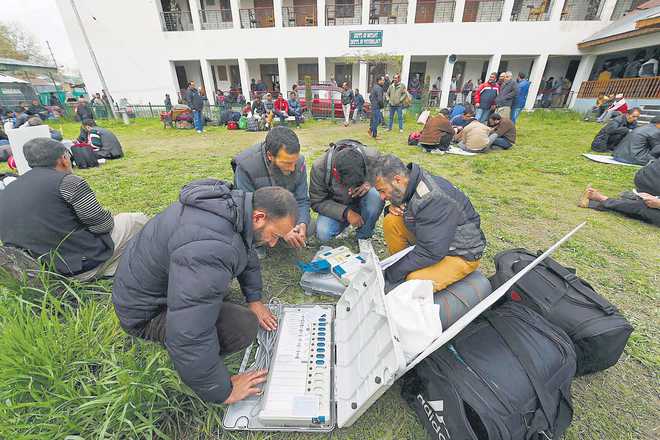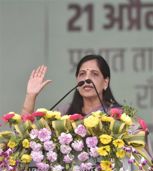
POLL CODE: The emphasis is on the possibility rather than likelihood of misuse.
Yogendra Yadav
JUST when the EVM debate should have died with the introduction of new VVPAT machines, it has resurfaced. Just when the defeat of the ruling party in the critical bypolls should have reassured the Opposition, many opposition leaders are again demanding paper ballots. Just when the Election Commission should have gone out of its way to address concerns about new EVMs, its denials have given a new lease of life to this debate.
Almost everyone I know is by now an EVM-sceptic. They suspect that the BJP’s astounding electoral victories in the first three years were not possible without some tweaking of EVMs. They fear the same game will be replayed in the Lok Sabha elections. I disappoint them by arguing for the new EVMs.
The case against the use of EVMs rests on three reasonable apprehensions. First, the EVMs can, in principle, be manipulated. Second, the Modi-Shah duo is obsessed about winning elections at all costs and you cannot put any trick past them. Third, of late, the EC cannot be trusted not to bend to the needs of the ruling party. The apprehensions are well founded. But it does not follow that EVMs must have been, or shall be, rigged. Nor should we conclude that shifting from EVM to ballot paper is a necessary and sufficient solution.
Sadly, much of the debate on EVMs has focused on the possibility rather than likelihood of its misuse. The critics have weighed in with a lot of expertise to show that EVMs can be manipulated. The supporters, including the Election Commission, have given in to the temptation of arguing the opposite: that the EVMs cannot be manipulated. The simple fact is that any electronic gadget can be programmed and thus manipulated. The debate should not be on whether the EVMs can be compromised or not, but about the real-life conditions required to do so. We should focus not on the design of the machine, but on the administrative protocols that govern its use.
Only two features of the design of our EVMs are relevant to this discussion. One, that these machines cannot receive remote signal. If the EVM is to be manipulated, someone has to fiddle with each machine individually. Two, the chip does not recognise party symbols or names; it records votes by the serial number of the candidates. The serial number of the candidates is arranged alphabetically by the name of the candidate. Someone who wants the machine to favour a particular candidate or party has to fiddle with it after the candidates are finalised in each constituency and after a particular EVM is allocated to a constituency. This is usually a very short window of the last 72 hours or so before polling.
A reasonable case against EVMs would need to show that the administrative procedures in the days before polling allow physical tampering of EVMs. Before we believe that the recent elections have been rigged, we need some kind of evidence, even circumstantial, to show that such physical tampering did take place in some cases. There is no plausible evidence of either of these so far. The fact that the BJP won many implausible victories in several states is not good evidence of rigging. The history of Indian elections is full of such implausible and ‘unbelievable’ victories. Besides, it is hard to believe that the BJP would wish to follow up these grand victories with embarrassing outcomes in critical elections such as Gujarat and Karnataka. In any case, independent evidence such as post-poll surveys have tended to confirm most of these ‘implausible’ results, except UP.
One hoped that this old and tiring debate would come to an end with the introduction of the new type of EVMS, attached with VVPAT machines. This machine prints a paper slip that shows the symbol of the party that the voter just voted for. The voter, and only the voter, can verify the slip before it drops into a box, from where it can be retrieved for manual count, if necessary. The surest way of ruling out any manipulation in the EVMs now is to ensure that voters verify the paper slip and that the EVM count is matched with paper count, wherever necessary. The controversy about these machines in the recent bypolls was about machine failures and stoppages, not about mis-recording or mismatching of votes. The EC has already announced that all future elections, including the forthcoming Lok Sabha polls, will be held using VVPAT-enabled EVMs.
The sceptics should not spend their energy in asking for ballot papers, which are far more cumbersome and prone to greater manipulations. Instead, they should focus on developing foolproof protocols for the use of the new EVMs.
Here are some suggestions: First, instead of organising ‘hackathone challenge’, the EC must allow experts nominated by any registered party to examine a random sample of the new machines stored anywhere in the country. Second, election rules should be amended to allow a voter to register an objection, if he suspects that the paper slip did not match the party he voted for. If a booth records more than, let us say, 20 such objections, it should be mandatory at the time of counting to match the EVM count with the paper trail count for that booth. Third, there should be a publicity campaign to educate voters about the new machine and how to verify their own vote and register an objection, if necessary. This campaign should also address a rumour (heard during Karnataka campaign) that polling agents of various parties would be able to see the paper slip and know who voted for whom. Fourth, the rule about replacement of malfunctioning EVMs within 30 minutes, or repolling, should be strictly adhered to. Sufficient publicity should be given to the nature of malfunctioning that EVMs may develop and guidelines on responding to these.
Finally, the counting process should be altered slightly. The counting should begin with matching of EVM and paper trail count in one randomly chosen booth for each counting table. If there is no mismatch, the rest of the counting should proceed as it does today. As a measure of abundant caution, candidates who finish second and third should be able to call for paper trail matching in any one booth of their choice before the result is declared.
This change in procedure may delay the counting by an hour or more and rob some of the T20-like fun of the counting day. But that is a small price to pay for restoring public faith in this sacred ritual of our democracy and for laying to rest a damaging and rather needless controversy. The sanctity of democratic elections depend on everyone, including the eventual loser, agreeing on the rules of the game.
The writer is president of Swaraj India



























